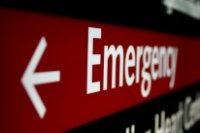
Emergency Preparedness and You
Emergency Preparedness and You
The possibility of public health emergencies arising concerns many people in the wake of recent earthquakes, tsunamis, acts of terrorism, and the threat of pandemic influenza. Though some people feel it is impossible to be prepared for unexpected events, the truth is that taking preparedness actions helps people deal with disasters of all sorts much more effectively when they do occur.
Below is a step by step guidance you can take now to protect you and your loved ones:
1- Get a Kit: Gather Emergency supplies. By taking time now to prepare emergency water supplies, food supplies and disaster supplies kit, you can provide for your entire family.
2- Make a Plan: Families can cope with disaster by preparing in advance and working together as a team.
3- Be informed: Learn where to have a safe shelter; and maintain a healthy state of Mind: Find ways of dealing with stressful situations.
1. Get a Kit
Gather Emergency Supplies
If disaster strikes your community, you might not have access to food, water, or electricity for some time. By taking time now to prepare emergency water supplies, food supplies and disaster supplies kit, you can provide for your entire family.
Even though it is unlikely that an emergency would cut off your food supplies for two weeks, consider maintaining a supply that will last that long.
You may not need to go out and buy foods to prepare an emergency food supply. You can use the canned goods, dry mixes, and other staples on your cupboard shelves.
Having an ample supply of clean water is a top priority in an emergency. A normally active person needs to drink at least 2 quarts (a half gallon) of water each day. You will also need water for food preparation and hygiene. Store at least an additional half-gallon per person, per day for this. You can reduce the amount of water your body needs by reducing activity and staying cool.
Disaster Supplies Kit
A disaster supplies kit is a collection of basic items that could be needed in the event of a disaster.
Assemble the following items to create kits for use at home, the office, at school and/or in a vehicle:
· Water - three gallons for each person who would use the kit and an additional four gallons per person for use if you are confined to your home
· Food - a three-day supply in the kit and at least an additional four-day supply per person for use at home
You may want to consider stocking a two-week supply of food and water in your home.
· Items for infants - including formula, diapers, bottles, pacifiers, powdered milk and medications not requiring refrigeration
· Items for seniors, disabled persons or anyone with serious allergies - including special foods, denture items, extra eyeglasses, hearing aid batteries, prescription and non-prescription medications that are regularly used, inhalers and other essential equipment.
· Kitchen accessories - a manual can opener; mess kits or disposable cups, plates and utensils; utility knife; sugar and salt; aluminum foil and plastic wrap; re-sealable plastic bags
· A portable, battery-powered radio or television and extra, fresh batteries
· Several flashlights and extra, fresh batteries
· A first aid kit
· One complete change of clothing and footwear for each person - including sturdy work shoes or boots, raingear and other items adjusted for the season, such as hats and gloves, thermal underwear, sunglasses, dust masks
· Blankets or a sleeping bag for each person
· Sanitation and hygiene items - shampoo, deodorant, toothpaste, toothbrushes, comb and brush, lip balm, sunscreen, contact lenses and supplies and any medications regularly used, toilet paper, towelettes, soap, hand sanitizer, liquid detergent, feminine supplies, plastic garbage bags (heavy-duty) and ties (for personal sanitation uses), medium-sized plastic bucket with tight lid, disinfectant, household chlorine bleach
· Other essential items - paper, pencil, needles, thread, small A-B-C-type fire extinguisher, medicine dropper, whistle, emergency preparedness manual
· Entertainment - including games and books, favorite dolls and stuffed animals for small children
· A map of the area marked with places you could go and their telephone numbers
· An extra set of keys and ids - including keys for cars and any properties owned and copies of driver's licenses, passports and work identification badges
· Cash and coins and copies of credit cards
· Copies of medical prescriptions
· Matches in a waterproof container
· A small tent, compass and shovel
Pack the items in easy-to-carry containers, label the containers clearly and store them where they would be easily accessible. Duffle bags, backpacks, and covered trash receptacles are good candidates for containers. In a disaster situation, you may need access to your disaster supplies kit quickly - whether you are sheltering at home or evacuating. Following a disaster, having the right supplies can help your household endure home confinement or evacuation.
Make sure the needs of everyone who would use the kit are covered, including infants, seniors. It's good to involve whoever is going to use the kit, including children, in assembling it.
Benefits of Involving Children
· Involving children is the first step in helping them know what to do in an emergency.
· Children can help. Ask them to think of items that they would like to include in a disaster supplies kit, such as books or games or nonperishable food items, and to help the household remember to keep the kits updated. Children could make calendars and mark the dates for checking emergency supplies, rotating the emergency food and water or replacing it every six months and replacing batteries as necessary. Children can enjoy preparing plans and disaster kits for pets and other animals.
Additional Supplies for Sheltering-in-Place
In the unlikely event that chemical or radiological hazards cause officials to advise people in a specific area to "shelter-in-place" in a sealed room, households should have in the room they have selected for this purpose:
· A roll of duct tape and scissors
· Plastic sheeting pre-cut to fit shelter-in-place room openings
Ten square feet of floor space per person will provide sufficient air to prevent carbon dioxide buildup for up to five hours.
2-Develop a Family Disaster Plan
Families can cope with disaster by preparing in advance and working together as a team. Create a family disaster plan including a communication plan, disaster supplies kit, and an evacuation plan. Knowing what to do is your best protection and your responsibility.
- Find out what could happen to you
- Make a disaster plan
- Complete the checklist
- Practice your plan
3- Be Informed
Learn How to Shelter in Place
"Shelter-in-place" means to take immediate shelter where you are—at home, work, school, or in between. It may also mean "seal the room;" in other words, take steps to prevent outside air from coming in. This is because local authorities may instruct you to "shelter-in-place" if chemical or radiological contaminants are released into the environment. It is important to listen to TV or radio to understand whether the authorities wish you to merely remain indoors or to take additional steps to protect yourself and your family.
How do I prepare?
At home
- Choose a room in advance for your shelter. The best room is one with as few windows and doors as possible. A large room, preferably with a water supply, is desirable—something like a master bedroom that is connected to a bathroom.
- Contact your workplaces, your children's schools, nursing homes where you may have family and your local town or city officials to find out what their plans are for "shelter-in-place."
Find out when warning systems will be tested. When tested in your area, determine whether you can hear or see sirens and/or warning lights from your home.
At work
- Help ensure that the emergency plan and checklist involves all employees. Volunteers or recruits should be assigned specific duties during an emergency. Alternates should be assigned to each duty.
- The shelter kit should be checked on a regular basis. Duct tape and first aid supplies can sometimes disappear when all employees know where the shelter kit is stored. Batteries for the radio and flashlight should be replaced regularly.
In general
- Learn CPR, first aid and the use of an automated external defibrillator (AED)
Contact the Red Cross for more Information
Reference cdc.gov





 Front Desk
Front Desk
 Patricia Aouad
Patricia Aouad
 Sarita Salameh
Sarita Salameh
